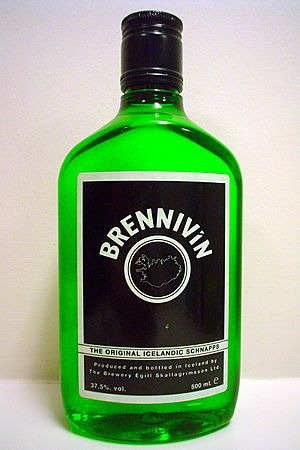Brennivín facts for kids
Brennivín is a special drink from Iceland. It is a clear, strong spirit. Many people call it Iceland's national drink. It is made from fermented grain and flavored with caraway. Caraway is a spice that tastes a bit like fresh rye bread. Brennivín is a type of aquavit. It is usually served chilled, often as a shot. People also enjoy it with beer or in cocktails. It is a traditional drink for the mid-winter feast called Þorrablót.
Contents
What Does "Brennivín" Mean?
The word "brennivín" means "burning wine." This name comes from old Dutch words. Many other Nordic languages use similar words. For example, in Swedish it is "brännvin." In Norwegian, it is "brennevin." This shows how these languages are connected.
The Story of Brennivín
The history of Brennivín is closely linked to Iceland's past. Iceland was settled a long time ago. In 1262, Iceland became part of the Kingdom of Norway. Later, it came under the rule of Denmark.
Early Drinks in Iceland
In early times, Icelanders could make their own mead. Mead is a drink made from honey. Sometimes, they could also make beer. But in 1602, the Danish King started a trade rule. This rule meant only certain Danish merchants could trade with Iceland. Other goods like mead and beer took up too much space on ships. Stronger spirits took up less space. They also did not spoil and could be sold for more money.
How Aquavit Was Born
The way spirits were made back then was called "burning." The drinks were not always very tasty. To make them better, people added herbs. Even in Iceland's cold climate, caraway was available. So, caraway was used to flavor the spirits from Denmark. This is how aquavit, including Brennivín, became popular.
Changes Over Time
The special trade rule ended in 1786. Later, new ways of making spirits arrived. The drinks became cleaner. But people still liked them flavored with herbs. For a long time, Icelanders were not allowed to make their own spirits. This was because a Danish company had control over it.
Alcohol Becomes Illegal
In 1908, Iceland decided to make alcohol illegal. This is called prohibition. From 1912, no alcohol could be brought into Iceland. Any alcohol already there had to be used up or destroyed by 1915.
Iceland Becomes Independent
In 1918, Iceland became independent from Denmark. This meant they could make their own rules. In 1935, the ban on alcohol was partly lifted. Strong spirits were allowed again. But the government controlled how they were made and sold. Beer stayed illegal until 1989.
The Birth of Modern Brennivín
The Icelandic government created a company to handle alcohol. One of the first spirits they made was caraway-flavored Brennivín. The government wanted the label to look very plain. It was black and white. The first bottles even had a white skull on the label. This was meant to make the drink look unappealing. It was supposed to make people not want to buy it. But it did not work!
Brennivín became very popular. It was a favorite drink for Icelanders. Travelers also bought it as a souvenir. In 2014, Brennivín was finally sold legally in America. By then, it had become a symbol of Iceland itself.
How to Enjoy Brennivín
Brennivín is usually served cold. You can drink it as a shot. Many people enjoy it with a beer. It is also used in cocktails. Sometimes, it takes the place of gin or light rum in mixed drinks. Brennivín is also a traditional partner for hákarl. Hákarl is a special type of fermented shark meat from Iceland.
Different Brands of Brennivín
Today, different companies in Iceland make Brennivín. Each brand has its own special touch. But they all stay true to the original taste. This taste was first made by the government-owned company.
Where Else Can You Find Brennivín?
Brennivín started to be sold outside Iceland in 2014. It first went to the United States. After that, it was sold in Germany and Canada. You can also find it in Denmark and Sweden.
Brennivín in Pop Culture
Brennivín has appeared in many parts of popular culture.
In Music
- The band Foo Fighters mentions Brennivín in their song "Skin and Bones." The singer, Dave Grohl, sometimes wears a Brennivín t-shirt.
- "Brennivin" is the name of a song by The Album Leaf project. It is on their Seal Beach EP.
- The Faroese band Týr has a song called "Brennivin." It is on their album, Land.
In Films and Television
- On the TV show "Blindspot," there is an Icelandic character. In one episode, the main characters all share a shot of Brennivín.
- Many Icelandic films have shown the drink. These include Kristnihald undir Jökli and Djöflaeyjan.
In a Japanese Webcomic
- A character named Iceland in the Japanese webcomic Hetalia: Axis Powers talks about this drink in his song, "With Love, From Iceland."
See also
 In Spanish: Brennivín para niños
In Spanish: Brennivín para niños



